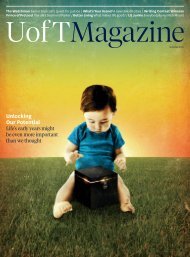The Next Big Idea 10 concepts that could - University of Toronto ...
The Next Big Idea 10 concepts that could - University of Toronto ...
The Next Big Idea 10 concepts that could - University of Toronto ...
You also want an ePaper? Increase the reach of your titles
YUMPU automatically turns print PDFs into web optimized ePapers that Google loves.
Time Capsule<br />
photo: university <strong>of</strong> toronto archives/a1978-0041/007(35)<br />
1962<br />
Defying Gravity<br />
Pr<strong>of</strong>essor Wilbur Rounding Franks<br />
developed the first G-suit used in combat<br />
Given the airborne talents <strong>of</strong> astronauts and fighter pilots,<br />
it’s easy to overlook the role <strong>of</strong> their high-tech uniforms. This<br />
picture from 1962 shows Wilbur Rounding Franks, a pr<strong>of</strong>essor<br />
in U <strong>of</strong> T’s Banting and Best Department <strong>of</strong> Medical Research,<br />
posing with the Franks Flying Suit. It is the first anti-gravity or<br />
G-suit used in combat, and is still the foundational design for<br />
contemporary fighter-pilot and astronaut pressure suits.<br />
Franks earned his BA at Victoria College in 1924, graduated<br />
from medical school at U <strong>of</strong> T in 1928 and worked in<br />
cancer research. After the death <strong>of</strong> his mentor Frederick<br />
Banting in 1941, Franks continued Banting’s research into<br />
aviation medicine and the problem <strong>of</strong> Allied fighter pilots<br />
losing consciousness during high-speed exercises. <strong>The</strong> pilots<br />
were subject to immense gravitational forces, making it<br />
difficult for the heart to pump blood to the brain.<br />
Franks initially came up with the idea <strong>of</strong> a water-filled<br />
G-suit. By filling an outer layer with water <strong>that</strong> pressed on the<br />
legs and abdomen to prevent blood from pooling in the lower<br />
parts <strong>of</strong> the body, Franks <strong>could</strong> keep the pilots’ blood circulating<br />
normally. His preliminary tests were on mice surrounded<br />
by condoms filled with water, and Franks eventually subjected<br />
himself to a barrage <strong>of</strong> successful tests in real aircraft. Later<br />
designs used air pressure instead <strong>of</strong> water pressure, and<br />
included an inflatable bladder. <strong>The</strong> Franks Flying Suit was first<br />
used in combat by the Royal Navy Fleet Air Arm in an invasion<br />
<strong>of</strong> North Africa in November 1942. – Sarah Treleaven<br />
64 WWW.MAGAZINE.UTORONTO.CA
















